A chance to get away from the coastal plain and climb up into the mountains that divide the Marche from Umbria, this tour features spectacular landscapes, some of Europe's most dramatic caves, Italy's paper capital, and the atmospheric calm of an ancient isolated monastery.
The route starts at Fabriano, one of the world’s oldest and most famous paper producing towns. No visit here would be complete without a trip round the paper museum, where you can still see paper being made by hand.
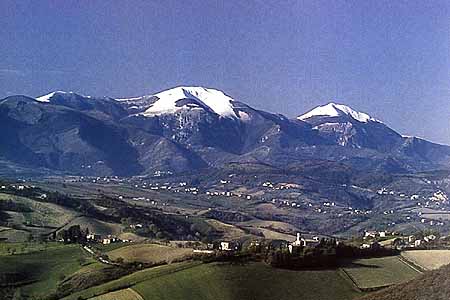
Monte Catria
From here the road heads up towards the spurs of high Monte Catria and some of the most awesome scenery on the tour. Along the way we visit one of the Marche region’s oldest and most beautiful monasteries at Fonte Avellana and the mountain eyrie of Frontone.
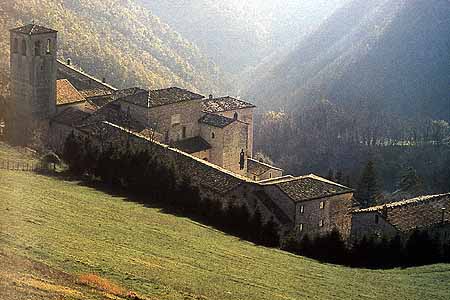
Eremo di Fonte Avellana
The next stretch of the tour heads down through the gentler countryside of the Cesano valley, taking in two homely small towns - Pergola and San Lorenzo in Campo - before making a short detour to see the picture postcard walls and keep at Mondavio.
Another beguiling hill town awaits us at Corinaldo on the other side of the valley. Here you'll also find the tomb of its young 20th century saint, St Maria Goretti. The return stretch back to Fabriano winds through green open countryside and a string of quiet small towns, including sprightly Arcevia, to arrive at the climax of the tour at the magnificent caves of Frasassi.
Fabriano stands within easy reach of Ancona along the fast SS.78. There are several hotels to chose from in Fabriano as well as at Jesi, just south of this tour.
The Route
Part I - Fabriano to Fonte Avellana
Leaving Fabriano, take the signs which lead you up an attractive valley to the prosperous town of Sassoferrato. Follow the museum signs up to the solid citadel and Medieval borgo high on a ridge above the modern town. Then stroll through the hushed cobbled streets, past a fine Gothic Franciscan church to arrive at the intimate Piazza Matteotti with its elegant arcades. The palace with the double ramp staircase, Palazzo dei Priori, houses the Museo Archeologico Sentinate, a collection of Roman mosaics, sculpture and funeral urns from the Roman city of Sentinum which stood on the plain just to the south of the modern town. It was here that the Roman army defeated the combined Samnite and Gaul forces in 295 BC. Recent archaeological excavations have unearthed various remains just to the south of the town but these are hard to find and strictly for the enthusiast. Nearby, in via Montanari, there is also a delightful museum of more recent relics from the rural past at the Museo delle Arti e delle Tradizioni Popolari as well as a museum of modern art.
The route now heads in the direction of Pergola, running alongside the railway track before turning left (just before a railway crossing) to Serra Sant’Abbondio and into the mountains. The pretty village of Serra Sant’Abbondio still has its walls to protect it. Through the medieval gateway, lines of crusty old houses line its narrow streets but the ancient castle which stood at the top of the central street was pulled down in the 1930s in preference for a nice modern town hall.
We now make a delightful detour to the Monastery of Fonte Avellana on the eastern flanks of Monte Catria in one of the most breathtaking settings imaginable. Its beauty is derived as much from the intentional poverty of the architecture as the magnificence of its proportions and the extraordinary size of the entire complex. Founded in 980, visited by Dante in 1310, and once presided over by St Peter Damian, this is one of the few monasteries in the Marche which retains its medieval monastic form. Guided tours take you to the extraordinary scriptorium. This was once an important centre for the production of illuminated manuscripts and was built with an ingenious system to maximise the hall’s natural lighting. There is also the Dante Alighieri Library, with rows of rare Seicento books and, of course, the church, with a simple single aisle and a flight of wide steps up to a raised presbytery. Beneath it, don’t miss the crypt, supported by mighty Romanesque arches, which is built with such finely cut stone that it seems almost as if the walls have been carved straight out of the rock.
Part II - Fonte Avellana to Mondavio
From the monastery the road snakes over a pass into the next valley, under the majestic peaks of the Catria (1,700 metres) and Acuto (1,527 metres) mountains, before descending to Frontone. Above the shapeless modern village stands a steep hill with just enough room on top for an imposing castle and medieval borghetto. As the last of a string of natural defences running from the sea to the impregnable Apennines, it has been fortified since the pre-Roman days when the area was garrisoned by the Eugubine tribes from Gubbio.
The well-restored rocca later helped to defend the southern border of the Duke of Montefeltro's lands and some consider the triangular tower at the western end to be the work of Duke Federico's favourite architect, Francesco di Giorgio Martini. This windswept look-out (note the size of the rocks on the roofs to stop the tiles blowing away) gives a splendid prospect of the surrounding mountains.
Leaving the highlands behind us, we now drive into gentler countryside of wooded hills and valley farms. The traditional mixed farming system can still be seen here, with long rows of vines planted between narrow strips of grain.
Just off the road lies the shapely small town of Pergola whose quiet streets have a refined and distinctly 18th Century air. Stop here for an ice cream at one of the bars along the corso and pick up a bottle or two of the heavily perfumed purple wine peculiar to the town, made with red vernaccia grapes and sold either as Vernaculum or Vernacolo.
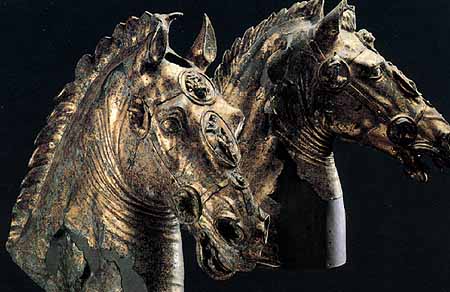
I Bronzi Dorati - Pergola
If you’re lucky you can mingle with the local farmers at the lively Saturday market. Sadly, the town’s star attraction is not on public display. The Bronzi Dorati, extraordinary Roman gilded bronze equestrian statues dating from the 1st century BC were found nearby in 1946 and are at the centre of a long-running row between the town council, who want to keep them here, and the regional authorities, who have prepared a special room for them at the archaeological museum in Ancona. For the time being they have been taken off to Florence for "restoration", and no one yet knows where or when they will return.
Continuing on along the Cesano valley, we pass through the main street of San Lorenzo in Campo lined with shady evergreen oaks. On the left the tiny church of San Lorenzo dates back to the 7th century and is built on pillars from a pagan temple.
A short detour takes us up onto the northern flanks of the valley to Mondavio. Bright geraniums and spreading cedars add a graceful tone to this beautifully preserved, small red-brick medieval hill town. The imposing fortifications that stand out from afar were built by Francesco di Giorgio Martini, one of Italy's most celebrated Renaissance military architects. They now house an entertaining 'living museum' (actually dead wax dummies) portraying life when the Rocca was built at the close of the 15th century for Giovanni della Rovere, son-in-law of Duke Federico da Montefeltro. There is also a grisly torture chamber to entertain the youngsters. If you’re around in mid-August there’s also a jolly medieval wild boar hunt around the main square.
Part III - Mondavio to the Frasassi Caves
The next leg of the tour takes us across the Cesano valley to another fortified town, Corinaldo. It boasts almost a kilometre of some of the best-preserved 15th Century defensive walls in the northern Marche - you can walk along long stretches of the battlements while admiring the sweeping views. The major attraction however is the tomb of the town’s twelve year old saint, St Maria Goretti.
A few kilometres further on we arrive at Ostra Vetere, whose harmonious roof-line is topped by the exuberant dome of the town’s neo-Gothic church. Once inside the walls, note how the streets run in parallel terraces, joined to each other by steep flights of steps and the occasional dicey lane. Now take the road which travels along a wide open ridge to the village of Barbara, passing through the clock tower gateway at the bottom end of the village. The remains of the castle are more apparent as you leave through the Castrum Barbarae gateway at the top of the village - look back to see the tower and turrets.
A few kilometres on we reach the noble town of Arcevia. Once you have twisted your way up to the top, the relative grandeur of the place comes as something of a surprise with several smart palazzi lining the main Corso Mazzini. Benign Piazza Garibaldi, half way along, is presided over by the town hall, topped by its 14th century tower. On the opposite side, a balcony under the arcades gives you a grandstand view out over the mountains to the south. The artistic high spot here is the church of San Medardo, half way up Corso Mazzini, where you can see two dramatically framed masterpieces by Luca Signorelli, painted while he was living here between 1507 and 1508, as well as an altarpiece by Giovanni della Robbia (1513).
Continuing on from here, the road curves through more dramatic scenery of wooded valleys towards Sassoferrato before turning off south to the soaring limestone cliffs of the Frasassi Gorge to reach the natural highspot of the tour. The Frasassi Caves are the largest caves in Italy and among the most spectacular in the whole of Europe.
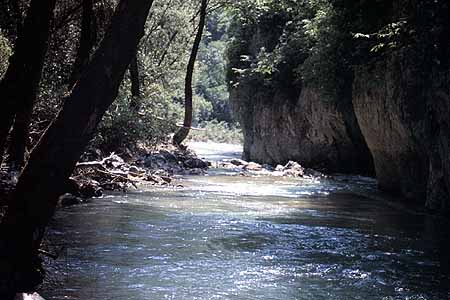
Gola di Frasassi attraversata dal Sentino
Before heading back to Fabriano, don’t miss the opportunity to visit a hauntingly beautiful Romanesque church in the little spa of San Vittore delle Chiuse (right by the cave ticket office and car park).
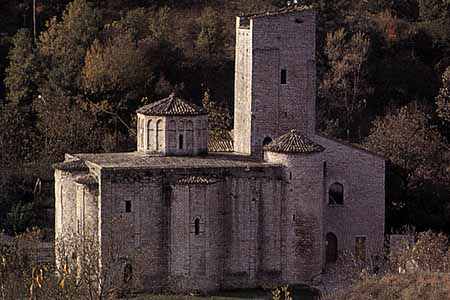
This tiny, perfectly square chiesetta was built in the 12thC on chastely simple lines and is one of the prettiest of its kind in the Marche. (when closed, ask for the keys at the tobacconist's opposite.)
Routes
Tour 1 - The Castles of Montefeltro
Tour 2 - From Paper to Stone
Tour 3 - The Vineyards of Verdicchio
Tour 4 - The Heartland of Le Marche
Tour 5 - In the Shadow of Monte Conero
Tour 6 - The Wild Mountains of the Sybil
Tour 7 - In the Footsteps of Ancient Rome
Tour 8 - Ascoli's Hidden Heritage
Tour 9 - Beside the Seaside
© Liberation Ventures Ltd.